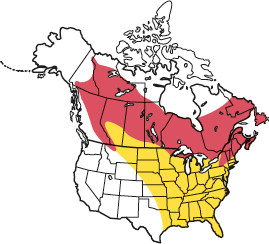Oreothlypis peregrina

male
The Tennessee Warbler is an active little songbird. The sexes are dissimilar. Adult males have an olive-green back and an olive-brown tail and wings, the latter with indistinct pale wingbars. The head is blue-gray with a dark eye stripe and a whitish supercilium. The underparts, including the throat, are whitish with a gray suffusion on the flanks. Adult females are similar to a male but less colorful and with a yellowish suffusion on the neck and breast. Adults of both sexes are more colorful in spring and summer than in fall. Immatures are buffish yellow with pale wingbars and a pale supercilium. The underparts are mostly pale buff but whitish on the undertail. In all birds the bill and legs are dark.
The Tennessee Warbler is present as a breeding species across much of northern North America, mainly from May to July. It spends the rest of the year in Central and South America. The species is usually easy to see both on its breeding grounds and on migration.

female
FACT FILE
LENGTH 4.75 in (12 cm)
FOOD Invertebrates, notably spruce budworms (larvae of moths belonging to the genus Choristoneura)
HABITAT Northern conifer forests
STATUS Widespread and common summer visitor
VOICE Song is a three-part series of chip notes, each part increasing in delivery speed. Call is a sharp tscht
![]()
